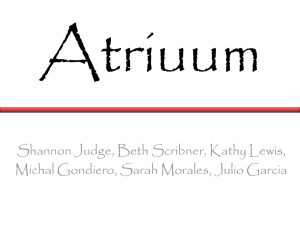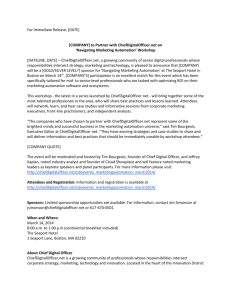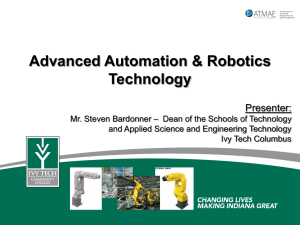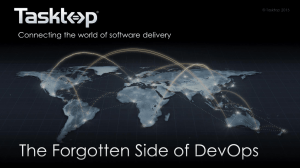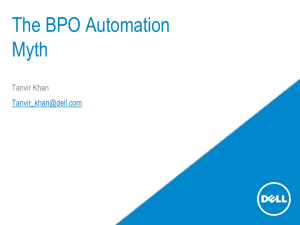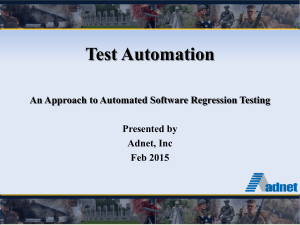Automation in Aerospace & Defense (A&D) Manufacturing
advertisement
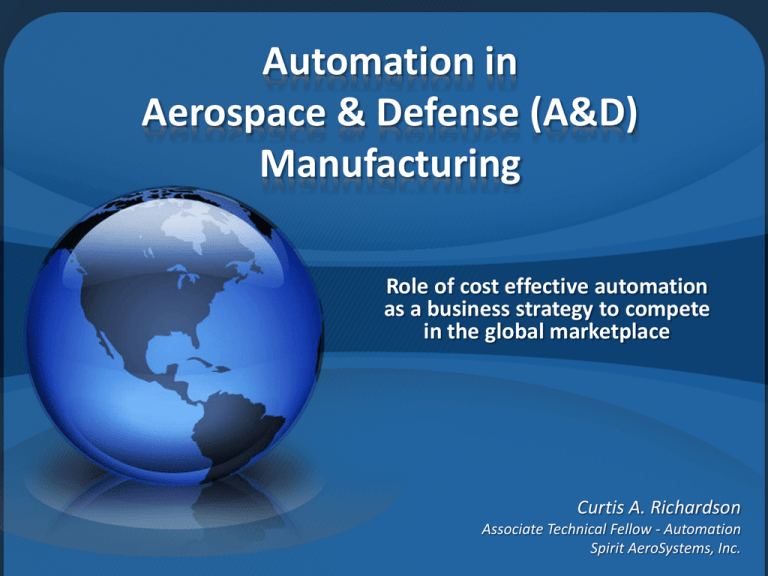
Automation in Aerospace & Defense (A&D) Manufacturing Role of cost effective automation as a business strategy to compete in the global marketplace Curtis A. Richardson Associate Technical Fellow - Automation Spirit AeroSystems, Inc. Why Automate? Increase/stabilize productivity or throughput Reduce/avoid/stabilize cost Improve/stabilize quality Improve safety, ergonomics Regulatory compliance Technology or capability enabler Traditional 2D Perspective Capability • • • • • • Monument Automation Flexible Automation Hand Tools Nonrecurring Cost Why Flexible Automation? • Installation, process integration flexibility • Cost-effective capacity scalability • Minimal lead times What’s so great about robots? • • • • • • • • • Relatively low capital cost Relatively low installation cost/requirements Process flexibility High degree of repeatability Offline TCP programming capability Range of motion, speed, payload Large network of integration specialists Mass produced Mature infrastructure *Traditional vs. A & D Use Traditional Industry Use Characteristics High volume, low mix Small parts Single-task oriented Cycle time (per part) measured in seconds/minutes Static cell / tooling configuration Low/no accuracy requirement Maximize robot motion speed Robot motion integral to the process Annual model run changeover Single model/part family focus Teach programming “Set it & Forget it” versus Typical A & D Use Characteristics * “Traditional” markets include automotive, electronics, etc. Low volume, high mix Large parts Multi-task oriented Cycle time (per part) measured in hours/days Mobile cell / flexible fixturing High accuracy required Application-dependent speed End effector function integral to the process No model run changeover Multi-model/part families Offline programming Cognitive interpretation *Traditional vs. A & D Use Welding: arc, spot, laser Assembly Cutting Grinding/Deburring Dispensing Machine Tending Trimming: routing, waterjet Packaging Palletizing Painting Polishing/Finishing Press/Forming versus Processes * “Traditional” markets include automotive, electronics, etc. Precision Drilling Fastening/Riveting Non-Destructive Inspection Sealing: fay, fillet, encapsulation Coating: paint, plasma spray Sanding Fiber/Fabric Placement Assembly & Fixturing Peening Friction Stir Joining Precision Routing Machining/Sculpting However, there are some issues… • Robotic automation not designed for most accuracycritical, high-force, interactive applications – Accuracy, stiffness, cognitive capability requires fundamental design changes – Perceived as relatively low-volume opportunity by OEMs – Deficiencies addressed at system integrator level (customization); unexpectedly high turnkey system cost – Diverse landscape of integrators can be confusing • 2nd tier measures to improve performance result in cost, reliability issues • Myriad safety, process integration inefficiencies • Complexity, idiosyncrasies of proprietary controllers • Fear of losing jobs to automation How do we address these issues? 1. Use what’s already working… Implement automation where current technology allows Gain familiarity, expertise 2. Establish internal automation infrastructure Skilled trades for programming, operating, maintaining Develop guidelines, standards for automation utilization Implement control, data network architectures 3. Adapt engineering designs, manufacturing processes Design for Automated Manufacturing (DFAM) crucial Greenfield scenarios vs. existing process improvements How do we address these issues? 4. Collaborate with each other SME Aerospace Automation Consortium SAE Aerospace Manufacturing & Automated Fastening Midwest Robotics Initiatives Council NSF Roadmap for US Robotics 5. Partner with OEMs, integrators, researchers Educating OEMs about process requirements, market potential will lead to new capabilities, designs Some progressive integrators already addressing issues Research institutions provide opportunities for shared resources, short-term results Use collaborative environment to garner government resources




